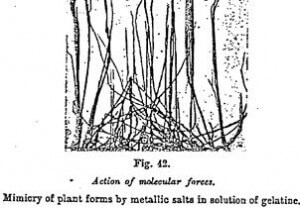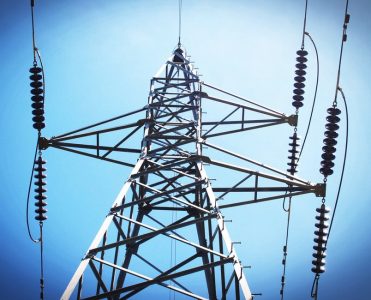Chapter I – Universal Gravitation and Hidden Forces
1. The Causes of Gravitation
The description of forces of unknown origin might really be applied to all those we have hitherto studied, since we are ignorant of their essence; but at least we know something of their characteristics and their mode of propagation. On the other hand there exist forces such as gravitation, affinity, molecular action, etc., of which we know almost nothing. For this reason they have been relegated to a special division of this book.
All our knowledge relating to gravitation can be reduced to the following definition; bodies attract one another proportionally to their mass and in inverse ratio to the square of their distance from each other. Of the causes of this attraction, of the manner in which it is propagated, and of the speed of its propagation, we can say nothing.
The discovery of the just-formulated law is, it will be remembered, due to Newton, and cost him long research. Gravity had been known a long time before, and Galileo had perfectly studied its laws. But how far did its actions extend, and did it pass beyond the limits of our atmosphere? Of that every one was completely ignorant.
The genius-inspired glance of Newton saw that weight might extend to the different planets and be the cause of their movements in space. He devoted many years of his life to the verification of the exactness of this hypothesis.
After having discovered the laws of gravitation, Newton vainly attempted to determine its cause. “The reason of the properties of weight”, he said, “I have not yet been able to discover”. Nor were his successors more successful. One gets clearer and clearer glimpses that weight is due to the relations between the ether and matter, connected doubtless by lines of force; but this is only a more or less vague hint which still escapes the teachings of experiment. It is possible that the gyratory movements of atoms are communicated to the ether, and through it to the different material bodies, thereby establishing an attraction between them. The reciprocal attraction of vortices has at the present day been demonstrated by many experiments. When the gyratory movement of the particle is transformed into movements of translation in space during the dissociation of matter, these particles no longer exercise any attractive action on each other, and consequently cease to be ponderable. This explanation was given by M. Armand Gauthier in a memoir referring to my researches.
Gravitation displays this incomprehensible characteristic, which no other manifestation of energy possesses, of not being arrested by any obstacle. The most delicate researches have shown that no body exists which is opaque to attraction.
Gravitation is a very small force, if we consider only the action of the masses we have at our disposal. But it is a force extremely great for considerable masses. Its power is apparent to us every day in the phenomenon of the tides. Under the influence of the combined motion of the sun and moon, the seas are raised an average height of 1 meter, which represented a weight of 1000 kg per surface meter.
Physicists have been able to say nothing more on gravitation than what is said above. In an important memoir, of which I reproduce a few passages, Prof. Vernon Boys has shown perfectly how inexplicable it remains. “It seems to defy”, he says, “all our attempts to abandon the inconceivable idea of action at a distance; for even when we might conceive another mode of action, it is entirely incomprehensible that gravitation should act at a distance without regard to the existence or nature of the bodies in its path, and, as it appears, instantaneously. Moreover, in the actual state of our knowledge, no other physical agent, even among those which depend upon the ether, has any influence over the direction or the extent of the notion of gravitation. The difficulties that we experience in creating a mechanical representation of the ether are considerable; but the mode of propagation of gravitation seems still further out of our reach” (Actes du Congres de Physique de 1900, t. iii, p. 306).
The speed of the propagation of gravitation was estimated by LaPlace as being immensely higher than that of light. M. Poincare considers it as propagated with a velocity of the order of that of the light-vibration.
We do not know how gravitation is propagated, but it seems to me that the law of the inverse square of the distance allows us to imagine gravitic waves having a form analogous to that of light, electric waves, etc. It is, in fact, only to forces which are propagated in this way that such a law is applicable. It is only a consequence of the geometrical properties of spherical bodies, and results simply from the fact that the surfaces of concentric spheres are proportional to the square of their radii. Place a candle in the center of a sphere of given radius, and each part of this sphere will receive a certain quantity of light. Double the radius of the sphere, and as the same quantity of light is spread over a surface four times greater than before, its intensity over the same extent of the sphere will be four times less; while with treble the radius, the intensity will be 9 times less, and so on. It would be the same if the source of light were replaced by a sonorous body. The intensity of sound per unit of surface would be, for the same reason, inversely as the square of the distance. This law of inverse squares simply signifies therefore that the intensity at a given distance is inversely proportional to the surface of the spherical wave propagated to that distance, which is geometrically evident. When a force decreases with the distance in accordance with this law, it is legitimate enough to imagine that it is propagated by spherical waves. This should be the case with gravity.
2. The Consequences of Gravitation
The laws of gravitation simply express this experimental fact, that all bodies exercise a certain attraction upon one another. From this phenomenon, apparently simple, although inexplicable, results the course of the stars, and, according to some physicists, all the forces of the universe, including those which governed the formation of our solar system.
It is, in fact, generally admitted that the central globe which was the origin of our own, must have been formed by the reciprocal attractions of the elements of the primal nebula.
The maintenance of the heat of the sun, whence is derived the greater part of terrestrial forces, must be the result, according to Helmholtz, of the progressive contraction of the sun following on the attraction of his elements for each other and the loss of vis viva [kinetic energy] which the molecules experience when coming close to each other.
It is likewise by gravitation combining its effects with those of inertia that the planets describe their orbits in space. A body launched in a straight line would continue its course I the same line by reason of its inertia, but if it be subjected at the same time to the action of a force which attracts it in a direction perpendicular to that of its course, its rectilinear trajectory is deflected and becomes a curve. Their inertia acting by itself would have compelled the planets when they detached themselves from the sun at the moment of their formation to continue their course in a straight line through space. On the other hand, had they not received this initial impulse, gravitation would have brought them together into one single mass. The result of these two antagonistic actions is the curve described by them round the sun, which can, according to the extent of the impulse received in the first instance, be a circle, an ellipse, parabola, or hyperbola. Certain comets alone seems to have a hyperbolic trajectory, for the planets follow ellipses which are almost circles. All the planets of course act upon one another, which is why Kepler’s laws are only approximately exact.
Centrifugal force, so named, results from this double action of the original impulse combined with gravitation. The star represents the stone held by the cord whirled by the slinger. The impulse received by the stone represents that received by the star, and the cord which keeps back the stone corresponds to attraction. This attraction is the immaterial string which attracts the star without ceasing, and compels it to treads a circular path. If it ceased to act for a single instant, the planets would escape into space in a straight line by following the tangent to their trajectory, like the stone which the cord fails to hold during its rotation.
Thus, then, the movement of the stars is the result of two causes: a permanent force (gravitation) which acts on them without ceasing, and an inertial impulse which has given to the star a certain velocity which it keeps by reason of the principle of inertia, whereby a body set in motion continues in motion. We are, then, thrown back on the mysterious property of inertia studied above, which is perhaps more incomprehensible than gravitation.
Gravitation, which is the origin of the forces and of the movements of the stars, is also that of the phenomenon called weight. This last is only a particular case if universal attraction, i.e., of the attraction which bodies exercise upon each other. When we say that a body possesses a given weight, it means that it is attracted by the earth. We measure the magnitude of this attraction by inquiring the pressure which it exercises on another body, the scale-pan of a balance for instance, or by opposing to it an antagonistic force of known magnitude, such as the elasticity of a spring or the attraction of a magnet.
We most often measure and utilize forces by putting them in opposition to weight. The greater part of our machines are constructed either to use weight or to strive against it. Industrial mechanics is in reality the art of utilizing weight and inertia.
Gravitation, inertia, and solar heat represent the three fundamental power utilized by man. If these magnitudes had been different, civilization would have taken a different aspect. So far as solar heat is concerned, we see this clearly when we notice how different are the fauna and flora at the Pole and at the Equator. Extreme heat and extreme cold alike seem to imply savage or at least barbarian life. Below 0° C and above 50° C, no civilization can be born.
We perhaps see less clearly the phenomena which differences of gravitation might generate. It is easy, however, to anticipate how different would be the conditions of our existence if weight were reduced or assimilated. At first sight, we seen to have no right to imagine its non-existence, since it is, like inertia, an irreducible property of matter incapable of modification, and following bodies through all their changes. But, if gravitation remains indestructible, its effects might be restricted or reduced to nothing. It has been calculated that it would suffice for the earth to turn 17 times as fast as it does now for the centrifugal forces to entirely annul the attraction of the earth’s mass on bodies at the Equator. They would then cease to have weight, and consequently would not fall back on the earth when left to themselves. Their weight therefore depends on the speed of rotation of our globe, which itself depends upon the impulse received in the first instance, when, under the influence of centrifugal force, it detached itself from the sun at the time of its formation.
There are other causes possible by which attraction might be annulled. It will be remembered that when the waves of light fall upon a source, they exercise a certain pressure upon it. It has been calculated that for portions of matter of small density and finely divided, the attraction of the sun might not only be annulled but even changed into a repulsion, which may be the cause of the deformation of the heads of comets. Poynting has calculated that a sun a the temperature of our own, it had only 32 km diameter, would repel, instead of attracting, all bodies less than 1 cm through.
It would be useless to dwell longer on these considerations, which show us merely how numerous are the possibilities of things, and how much the existence of living beings and all the ideas which we form of the world are conditioned by external forces from which we cannot withdraw ourselves. This is a self-evident notion, but one which certain philosophers rather forget.
3. Forces Dimly Seen
It is hardly to be imagined that the forces of nature are limited to the small number of those with which we are acquainted. If we are ignorant of them, it is because we have no reagents which disclose them. The discovery of appropriate reagents is the sole means of putting them in evidence. During the last 20 years, science has annexed the Hertzian waves, the x-rays, the cathode rays, the radioactive rays, and intra-atomic energy to the small kingdom of the forces known of old. It is difficult to believe that the end of these discoveries is reached, and mighty forces may surround us without our knowing it. Electricity, unknown for thousands of years, would perhaps still remain so if all bodies were good conductors.
This is no pace evidently for a dissertation on things of which we are ignorant. One ought first to try to discover them. A few hints hardly allow us to suspect their existence.
Our means of research are generally the verification of attractions and repulsions, and do not take us very far. Several times, however, the attractions and repulsion which a light needle suspended by a thread of raw silk experiences when approached by a living body has been pointed out; but they are perhaps due merely to the action of heat. (1).
[(1) Mr Legge tells me that he has established the fact that those actions do not manifest themselves through a vacuum. I made some experiments with this some years ago, and gave in an article in a popular magazine, Pall Mall Magazine, April 1902, a description of an apparatus which I believe to be very much more sensitive than that referred to in the text. Recently, however, it occurred to me to surround the apparatus with what is known as a vacuum jacket, to invert over it a double bell glass, having a vacuum between its outer and inner walls. With this, the needle remains motionless, no matter what bodies are brought near to the outer cover of the apparatus. As a vacuum cuts off not only electrical influences but also heat rays, it seems most probable that the motion of the needle is, in the cases originally quoted, the result of convection current formed by heat in the interior of the receptacle. — Ed.]
We are, then, here entirely within the domain of pure hypothesis, and we ought not to stay there long. Let us merely say that intra-atomic energies are a source of many possible varieties of energy. Mr Georges Delbruck, an engineer, has suggested that the larger birds, whose soaring flight without apparent motion is so difficult to explain, may have the faculty of generating at the expense of intra-atomic energy a force capable of striving against gravitation until it renders it null. This hypothesis is very difficult to verify, but it is not fundamentally absurd. Gravitation is only an attraction, which can be annihilated by a corresponding repulsion, as that exercised on masses of iron can be annulled by a magnet.
This theory will delight the spiritualist, who believe that they have verified the levitation phenomena which objects in relation with certain persons seem to present. Nevertheless, before explaining these levitations, their reality must first be rendered beyond dispute.
As to the so-called psychic forces, materializations, etc., it will be useless to busy ourselves with them here. They have attracted attention of eminent scholars, such as Crookes, Lodge, Richet, and others, but they have yet to be demonstrated, and until this is done, it is better to try to interpret the phenomena observed by known causes. I had occasion to examine without prejudice, and with the assistance of M. Dastre, a subject, with a European reputation, but our investigations, continued throughout several séances, disclosed to us nothing demonstrative. The story of the N-rays, moreover, shows us the difficulty of thorough observations in similar matters, and of avoiding causes of error. Before building a temple to unknown forces, we ought to be perfectly certain that they do not issue wholly from that domain of illusion in which all divinities have hitherto been born.
Chapter II – The Molecular and Intra-Atomic Forces
1. The Attractions and Repulsions of the Elements of Matter
Several chapters of The Evolution of Matter were devoted to the study of the equilibria of the elements of matter, and the forces of which they are the seat. We will run through them again to show how…
[ Pages 353-354 Missing ]
action is apparent. We call lines of force the directions in which the attractive and repellent effects are produced. While very easy to observe in electrical phenomena, the molecular fields of force due to other actions, may be made equally evident by different artifices, as shown in The Evolution of Matter.
The most important of the molecular forces is that called cohesion. The existence of the bodies of which the universe is formed is due to its influence. It conditions their forms. Without its action the word would vanish in an invisible dust of ether.
Although cohesion is an extremely powerful force, as is proved by the huge mechanical effort necessary to separate the particles of bodies, we possess in heat the means of annulling it.
As soon as the molecules are sufficiently separated by heat, the most rigid body loses its consistence and becomes liquid or gaseous. The very fact that there is no cohesion as soon as the molecules are apart from each other, proves that the molecular attractions which produce cohesion only act at a very small distance. Bodies in powder, even when strongly compressed, do not become hard for this reason. However near to each other these particles may be brought by pressure, they are still not enough to attract one another. To bring them near enough for this purpose demands an enormous pressure. Spring was thus able to form blocks of brass by energetically compressing powdered copper mixed with powdered tin.
Simple cooling produces the same effect, which is why, when we allow a melted body to cool, it returns to the solid state. Temperature constitutes one of those specially appropriate reagents of which we have so often taken occasion to show the importance. To separate the molecules kept together by cohesion demands an enormous effort, while only a relatively feeble one is necessary to separate them by heat.
Nothing resists the molecular forces. We can split a bombshell full of water by freezing it. We have only to touch a body for its molecules to separate a little.
Cohesion, which is already much reduced in liquefied bodies, disappears altogether in gaseous ones. Far from attracting each other, the molecules of gases behave — at least in appearance — as if they repelled each other. Thus, the smallest quantity of gas, introduced into a receiver, spreads into all parts of it. To compress a gas — to force its molecules to draw together — a considerable pressure must be exercised upon it.’
In solution, the molecules of the dissolved bodies behave in a similar way. They exercise upon the walls of the vessel containing them a pressure called osmotic, which is easily measured. The solution of a body has for this reason been compared to a gas.
In the energy of cohesion we have therefore a force which is very great, but which has the characteristic of only acting upon the particles of bodies when they are a very small distance apart. This peculiarity is not found in the attractions which constitute gravitation. This acts on all bodies at all distances.
We can form a summary idea of the forces which may produce cohesion by creating something similar in a body — that is to say, a force capable of generating attraction. If we cause an electric current to circulate in a metal wire surround an iron rod, we give to the molecules of the rod a power of attraction sufficient for them to exercise upon a piece of steel an attraction which may rise as high as 100 kg/sq cm. In the field of force surrounding the metal, a considerable attraction may also be exercised. One thus has a glimpse of the way in which the ether can assume a form making it capable of exercising extremely energetic attractions.
It has just been said that molecular attraction and repulsions are only manifest at a slight distance. There are, however, some which act from fairly far off. A piece of charcoal cooled to -200° C will so energetically absorb the air of the receptacle in which it is placed as to make a vacuum in it. A hydrometric body acts in the same way in respect of the water vapor surrounding it. Tantalum, heated to 600° C in an atmosphere of hydrogen, absorbs 600 times its volume of the gas in which it is plunged.
2. The Molecular Equilibria
All the attraction and repulsions just spoken of are in equilibrium with each other, and also with the external forces surrounding them. Matter, which was formerly conceived to be independent of its surrounding medium, represents only a state of equilibrium between the external forces of which it is the seat and the external forces which envelop it. The most rigid body is transformed into vapor as soon as this medium is sufficiently changed. In fact, we cannot define any property of a body — inertia excepted — without mentioning the conditions of the medium in which it is plunged. Even when we do not see their variation, the properties of a body follow the least changes of its medium to put themselves in equilibrium with it. It suffices to bring the hand near matter for its equilibria to be modified. A variation of one-millionth of a degree in the medium in which it is plunged varies the electrical resistance of a body in a way detectable by our instruments. The bolometer is based on this principle.
If we wish to point out the physical properties of any substance — water, for instance — we must always for completeness give the conditions of the medium. Two different saline solutions with the same osmotic pressure have the same freezing point; while the vapor-pressures of liquids are equal at temperatures equally removed from their boiling point, and bodies of the same atomic weight possess the same caloric capacity, etc.
Van der Waals has gone further still in his law of corresponding states, which shows that if the volume, pressure and temperature are estimated by taking as units the initial quantities, one equation is enough to translate the properties of all fluids. This means that all have the same properties in corresponding states (1).
[(1) The generality of the law of corresponding states is here rather exaggerated. It seems to be true for certain derivatives of benzene only. See Poincare, The Evolution of Modern Physics, p. 113)
3. The Force and the Form
By molecular attractions and repulsions we can go very neat to an explanation of certain phenomena, but our ignorance in regard to the causes which give matter its form is complete. Why, for instance, do liquids when solidifying take certain regular geometrical forms which are invariable for each body? The hidden causes of the form of a crystal are as unknown to us as those of a plant or an animal. These things happen as if physico-chemical phenomena were governed by unknown forces, which compel them to act in a predetermined direction.
We may, however, in some sort comprehend the genesis of a few forms by reducing them to extremely simple cases — for instance, the molecular attractions within a liquid. When we introduce into an aqueous solution a drop of liquid of different osmotic pressure, the molecules of the two liquids are attracted or repelled, and sometimes form fairly regular figures. We may also, by combining attractions and repulsions of electrical origin, obtain greatly varied figures. Some have been given in The Evolution of Matter, which were formed by combining the attractions and repulsions of the particles of dissociated matter.
By similar means we may obtain figures imitating plants. For the last 20 years certain observers, like Traube, have exercised their ingenuity in creating such reproductions. Of these, M. Stephane Leduc has obtained the most curious results, as may be judged by the figures given here. The mode of production indicated by him is very simple: “A granule of copper sulfate 1 mm to 2 mm diameter, composed of two parts saccharose, 1 of copper sulfate, and water to cause it to granulate, is planted in an aqueous solution containing 2% to 4% of potassium ferricyanide, 1% to 10% sodium chloride and other salts, and 1% to 4% of gelatine. It germinates in a space of time which varies from a few hours to a few days according to the temperature. The granule surrounds itself with a membrane of copper ferricyanide permeable to water and certain ions, but impermeable to the sugar enclosed within it, which produces in this artificial seed the strong osmotic pressure which determines its absorption and growth. If the liquid is spread over a glass plate, the growth takes place on the horizontal place; if the culture is made in a deep basin, it takes place at once horizontally and vertically. One single artificial seed may give 15 to 20 stalks sometimes as high as 25 cm”.


We may think we see here the image of life, but there is hardly any more connection between these artificial plants and real ones than there is between a living man and his statue. Their production merely shows that osmotic equilibria may condition certain external forms.
We have studied in this chapter only the relatively simple forces — primary forces, we might say — that govern the mineral world. They are, however, very obscure. When we come to the forces which direct the phenomena of life, the obscurity becomes greater yet.
Chapter III – The Forces Manifested by Living Beings
1. Living Matter and Cellular Life
We observe among living beings very distinct manifestations of energy: (1) physico-chemical forces, such as heat, light, electricity, described in physics; and (2) those united under the name of vital forces, of the nature and mode of action of which we are profoundly ignorant. For the sake of completeness I am obliged to speak of these last, but I do so with the certainty that I can say nothing useful on the subject. To descant on the phenomena of life while we are incapable of explaining why the stone which leaves the hand falls to the ground is a task which must be left to the leisure of metaphysicians.
The sole interest which this chapter may possess lies in its showing exactly the present limits of our slight acquaintance with those still very incomprehensible phenomena, the synthesis of which constitutes life. All living beings without exception are composed of an aggregate of little microscopic elements called cells. These, although if such an extreme minuteness that their diameter hardly exceeds some thousandths of a millimeter, have yet an extremely complicated structure, and properties even more so.
In a very summary way we may say that they are composed of a granulous substance called protoplasm, containing in its midst a nucleus of filaments. The microscope has shown the structure of this dust of life, but the marvelous part is that which we do not see, It contains, in fact, the germ of ancestral forms and those which will be born in the future course of its evolution. Every living being is derived from one primitive cell — the ovum, the transformations of which suffice to form a complete being in a very short space of time.
These cells, then, constitute the materials from which living beings are built. The lowest of these beings are composed of a single cell. They multiply, stick together, and are associated with the higher ones to form their different organs. The higher being is therefore a veritable society of cells having each its destined function, but working together in the general interest. The higher animal possesses a nervous system which puts the organs formed by the cells, and the digestive and circulatory apparatus which brings to them the elements of nourishment, in relation with one another, while the other organs are charged with the expulsion from the system of the remains of their nourishment, and so on. The whole living being labors to maintain the cells; they depend on it, and it on them.
The protoplasm of which the cells are composed represents the stock of life common to all living things, from the most humble to the highest. It fulfills universal functions, assimilation as well as destruction, and, from the chemical, anatomical, and physiological standpoints, seems to be little modified from one being to another, while its forms change to an infinite extent. Nature, which economizes her efforts, has need of little in order to vary the elementary structure of beings.
It is by the study of the life of cells that we may best understand the profundity of the mystery of life and its amazing complexity. To show this it will be enough to recall what appears on this subject in The Evolution of Matter.
The chemical studies which humble cells know how to manufacture comprise not only the most skillful operations of our laboratories, such as etherification, oxidation, reduction, polymerization, and so on, but many others demanding still more skill which we cannot imitate. By means which we do not even suspect, the vital cells construct their complicated and varied compounds — the albuminoids, cellulose, fats, starch, etc., necessary to the support of life. They are able to decompose the most stable bodies, such as sodium chloride, to extract the nitrogen from the ammoniacal salts, and the phosphorus from the phosphates, etc.
All these labors, so exact and so admirably adopted towards one end, are directed by forces of which we have no idea, and which behave exactly as if they possessed a second sigh far superior to our reason. That which they are accomplishing every instant of our existence soars far above all that the most advanced science can realize. The scholar capable of solving by his intelligence the problems solved every moment by the cells of the lowest creature would be so much higher than other men that he might be considered by them as a god.
Although protoplasm is the seat of an incessant activity, it is only slowly renewed in each being, and does not in fact contribute to its support out of its own substance, but by the materials it incorporates. It hardly uses itself up more than an engine fed by coal.
2. Instability is the Condition of Life — Part Played by the Intra-Atomic Energies
Life is only maintained by an incessant using up of the materials borrowed from outside. The cell assimilates and destroys without pause. Instability is the law of life. As soon as it is succeeded by stability there comes death.
Life is, then, the result of a constant exchange between the living being and the medium in which it is plunged, A being cannot be isolated from this medium, and would even be incomprehensible without it. It is the differential action of assimilation and destruction which governs the ascending or descending evolution of beings throughout their existence. Te cell dies without ceasing, but as it is renewed without ceasing, the living being has an apparent stability. It resembles a building the stones of which are every day removed by cunning demons, but are immediately replaced by other demons. The building does not change its appearance, and only begins to grow old when the restoring demons incompletely perform their task. The day when they no longer fulfill it, the building falls in ruins.
The maintenance of life represents a great expenditure of the energy furnished by food. With a great number of animals this last is constituted of vegetables, which by themselves can raise mineral matter to the degree of complexity necessary for the creation of chemical compounds charged with a slight volume of unstable energy. Thanks to them, matter is unceasingly raised from the unorganized state, to return at length to the starting-point.
But if the instability of the chemical elements of the cells is the very condition of life, does not the instability of the atom also play a part in these phenomena? I would not seem to exaggerate the influence of that intra-atomic energy which I have already made use of to explain many phenomena, but one must believe that its possible part in vital action is often present to the mind, for I have received letters from many doctors on this subject. I should not, however, have spoken of this, if experimental facts did not seem to demonstrate that the dissociation of matter may be manifested within the organism. Thus, for instance, Prof. Dufour has recently shown that air that has been breathed contains radioactive particles. Now these particles result, it will be remembered, from the dissociation of matter. I am also led to believe — and M. Dastre, to whom I have submitted my hypotheses, entirely admits the fact — that we must seek in atomic dissociations for the origin of the increase of energy produced by certain excitants, such as cola, caffeine, etc., whose composition clearly shows that they cannot be considered as foods. Some diastasic actions may well have a similar origin. The elements of protoplasm are considered at the present day as very unstable colloidal substances, and I have shown that these substances often come from the dissociation of matter. Given the colossal energy of intra-atomic energy. We can understand that the cell may become a mighty generator of energy without its composition being perceptibly altered [Biological transmutation. — Ed.]. It must also be remarked that physiologists have never succeeded in furnishing an acceptable theory of the action of the excitants spoken of above. I hope that what has been said will permit them to give some explanation of these phenomena. These intra-atomic energies, set free within the organism, seem, moreover, of rather exceptional occurrence, and only intervene under the influence of certain excitants, when the living being is obliges to make a considerable effort rapidly. In normal conditions the forces which it manifests have especially as their origin the chemical energies which come from foods.
These last may be very varied, but may be reduced, it will be remembered, into three categories:
(1) Albuminoids (egg white, animal flesh, etc.)
(2) Carbohydrates (starch, sugar, etc)
(3) Fats
We must add to these the oxygen of the air absorbed by respiration and necessary to displace, by combining with them, the energies of the chemical compounds introduced into the organism.
The food value of alimentary substances is sometimes estimated by burning them in a calorimeter and measuring the calories they produced. This rather barbarous process would lead us to consider coal and petroleum as valuable foods, as they disengage by their combustion many calories. One kilogram of coal generates about 8000 calories, while the adult uses only about 2500 a day. Prof. Chauveau has said: “We must give up looking for the nutritive value of food in their heat of combustion. The theory of food and alimentation cannot be presented under so simple a form”.
All foods produce heat, but this being the last term of the energetic changes of the organism, and not the first, it is evident that it is not this which generates the vital forces. Its part seems to be merely to put the elements of the organism in the conditions necessary for their proper working. M. Dastre made this point evident some time ago.
When all the foods have given up their energy to the organism, they are cast forth under different forms, such as water, carbonic acid, urea, etc., deprived of usable energy.
To sum up, we see that the vital forces are maintained by the chemical forces derived from the food, and that it is these last which uphold the first.
3. The Forces Which Regulate the Organism
Even when we liken to physico-chemical forces the vital forces manifested by living beings, it must be recognized that some things happen as if there existed quite peculiar forces, some of which are intended to regulate the functions of the organs, and others to direct their forces. They must be described, for the sake of clearness, by a name, although they probably are only a synthesis of actions which are very different and not yet dissociated. We will call the first category regulating and the second morphogenic (i.e, generators of forms) forces.
In spite of the efforts of thousands of workers, physiology has been able to tell us nothing of the nature of those forces. They have no analogy with those which are studied in physics.
The regulating forces act as if they watched over the proper working of the living machine, regulating the temperature and the constancy of the composition of the blood and other secretions, limiting the oscillation of the different functions, adapting the organism to the changes of the outer world, etc. They hold undivided sway over that region of unconscious life which constitutes the greatly preponderant part of the existence of beings. The philosopher may deny their existence, but the physiologist, who sees them perpetually in action, hardly contests it. He generally recognizes, like Claude Bernard, true “directing principles which direct phenomena which they do not produce and physical agents producing phenomena which they do not direct”.
These real or apparent directive actions formerly caused us to admit the existence of immaterial agents, the soul or vital principle, independent of the body and capable of surviving it. In reality it is not one single directive soul that we should have to imagine, but many souls, for the life of an individual appears to us as the sum of small cellular lives almost infinite in number, and all fulfilling very different functions. Thanks to these directive forces, nature shuts up each organ in the sphere designed by her, and constantly brings them back to it with the two great springs of all the activity of beings — pleasure and pain.
The regulating forces present the peculiar characteristics of being conditioned by a long ancestral past and of modifying it in every generation. The most modest cell, an amoeba or a globule of protoplasm, is charged with a past. To this must be attributed the variety of the reactions of living beings under the influence of external agents. In any vital act, and psychical manifestations must be included among them, our ancestors act as well as ourselves, but as their number is immense, there exists in every being the possibilities of action dependent on excitants capable of calling them forth. Many ancestors speak in us, but according to external circumstances they are not all equally heard. It is exactly this enormous past with which the least cell is saturated which makes so illusory our attempts to create living matter. “To create living matter!”, writes M. Gustave Bonnier. “How can it be hoped for in an instant in the present state of science, when we think of how many accumulated characteristics, how much heredity, how much complicated future, there are in a fragment of living protoplasm? If we think that the development of a higher animal, its successive transformation in the embryo into a protozoan, into a worm, into a fish with gills, finally producing a mammal, a man — and that all these future forms are found potentially in a microscopic fragment of inchoate living substance! If we reflect that this reminiscence of distant ancestors, this heredity acquired during tens of thousands of centuries all exist in this minute drop of protoplasm, we then understand the meaning of the truth, that it is not more difficult to create afresh a living animal — an elephant for instance — than to create a speck of living matter. When man shall solve this last problem, he will have become more creative than the Creator, stronger than all Nature, mightier than the Universe itself!”
4. The Morphogenic Forces
The acquisition of a specific form belongs as well to minerals as to living beings, since mineral can assume the geometric contours characteristic of each. We have already studied their genesis when speaking in The Evolution of Matter of the life of crystals.
But these substances of the mineral world only represent a very low order of life, fixed to some extent in invariability of form, and there is only a distant analogy between the life of an animal which constantly assimilates and destroys, and the immobility of a crystal. It does not represent a living form of matter, but only the ultimate term of life.
The medium supplies to the living being the matter of which it is composed, the energies which it expends, and the excitants which put it into play. All these external conditions may modify its form, but they act on a basis of life that they cannot create. Until now only life has been able to create life. That it may have been born spontaneously at the dawn of the geological ages under the influence of unknown reactions is very probable, for it must needs be that life has a beginning, but we cannot say why it began, and we do not know how to make it begin again.
The living being alone, then, enjoys the property of generating a substance analogous to its own and possessing the same forms. Every cell, and even every organ, possesses the mysterious power of creating forms similar to itself. Among the lower animals. Very part of the animal when but in pieces reproduces the wounded part. Among animals of fairly high organization, such as the tritons and the salamanders, a limb cut off, an eye torn out, is soon reborn.
By going back to the real origin of each living being — i.e., to the cell from which it is derived — we see better the inexplicable side of these morphogenic forces. This primal cell will undergo, tanks to them, the series of transformation which lead it to form a tree, a bird, a whale, or a man. It contains then, potentially, all the forms which go forth from it, and which always evolve in the same way for each species.
Such forces are, as M. Dastre has justly observed, “the most refractory and the most out of the reach of physico-chemcial explanations. How shall we explain”, he says, “this unfathomable mystery which makes the egg cell, drawing to itself materials from without, progressively build up the astonishing construction which is the body of an animal or of man himself?”.
All our attempts at interpretation of such a phenomenon are so perfectly futile, that it is better to give them up than to formulate them. The eminent physiologist last quoted points this out: “The naturalists give us nothing but words. They speak of heredity, of adaptation, of atavism, as if they were real and efficient beings, while they are only appellatives and names which are applied to collections of facts”.
These terms of adaptation, heredity, etc., are, however, not entirely vain words if we use them to simply translate facts of observation instead of considering them as explanations. They mean simply that forces utterly unknown, and of the nature of which we can have no suspicion, oblige the primal cell of a being to become an animal or a plant, and to bequeath to the beings derived from it the changes to which it has been subjected by different actions, such as that of the medium. As the cell possesses such powers, we conceive that, in the immense ages of the past, forms adapted to all the variations of the medium may have succeeded each other. It would seem that with a common stock of life, a sort of clay of beings, nature has tried numberless combinations, of which some only have been able to survive. We meet at the present day in geological debris some which seem the fancies of artists haunted by the visions of demoniacs. Such are, for instance, the gigantic Diplodocus, the Brontosaurus, and others, true dream monsters.
All these varied efflorescences of life formerly appeared to materialists as the fancies of a Creative Power drawing them forth periodically from the chaos which preceded the expression of his will. The immense service which Darwin rendered to the scientific mind was to eliminate the supernatural causes of the concatenation of things by making us see that laws which know no caprice, such as adaptation, selection, and the survival of the fittest, can explain the transformation of living beings. The theory of evolution is tending to be in part replaced at the present by that of abrupt mutations, the existence of which among certain vegetables has been disclosed by patient observations. But by showing us the possibility of finding scientific explanations in a domain where they seemed to have no place, Darwin changed the orientation of ideas in the most important branches of scientific activity. During half a century the learned world has been inspired by the doctrines of this mighty genius. One may say of the Origin of Species what Sainte-Beuve formerly wrote of the Esprit des Lois: “There is no book which we can quote as having done so much for the human race at the time when it appeared, and from which a reader of our day can draw so few applicable and positive ideas. But this is the destiny of nearly every work which has caused the mind of man to progress”.
The theory of abrupt mutations, which has shaken some fundamental facts of Darwin’s doctrines, is still in its infancy. The mutations which have been observed are rather rare, and do not bear upon fundamental characteristics. We have been able, however, to make use of them to obtain new species of cereals, the characteristics of which are reproduced by heredity with regularity and constancy. The scientific and philosophic importance of these mutations especially lies in the establishment of the notion that certain changes, prepared doubtless by an invisible and previous evolution, may take rise abruptly.
This fact will perhaps explain to us why at certain geological epochs there have suddenly appeared a whole series of living species so different from those which went before and those which come after them, as to make it very difficult to establish a link between them. The lacunae which science has vainly sought to fill should then, as Cuvier thought, be very real.
We assuredly observe in the succession of beings a certain continuity, a general direction, but not that regular and lineal continuity which many naturalists still imagine. If the evolution of beings is represented by a curve, this curve should indeed have a general regular trajectory, but would contain many solutions of continuity and loops.
The evolution of beings seems to have been obtained only at the price of repeated essays which seem useless enough to the human eye. From the point of view of our limited intelligence, we might say that things happen in nature as if they were sometimes directed by superior intelligences, and sometimes by absurd combinations due to blind grouping of improbable chances. Nature seems to be at the same time full of foresight and of blindness. It is very possible, however, that both the foresight and blindness are only in our minds. She has no doubt as guide and as means of action elements which we do not suspect, and we cannot in consequence judge her. We must always distrust hypotheses made on the subject of a domain which no human eye has ever seen.
Nor is there any occasion to bring into our explanation of things supreme beings with whom we are not acquainted. It was by eliminating them that science effected her greatest progress. We have seen that simple cells realize in the organism chemical operations beyond the resources of our laboratories, and act as if they were unceasingly guided by a superior intelligence. No one imagines, however, that there is such an intelligence behind each cell, and there is no occasion to imagine it for the aggregate of cells which constitute any animal whatever. Their structure disclosed an extremely skillful mechanism directed by forces of which at the present day we do not know the nature, but which we may hope to one day bring within the cycle of our knowledge.
5. The Interpretations o the Phenomena of Life
What has been said shows that the phenomena of life were always the stumbling block of philosophy and physiology. “Physiology”, writes M. Dastre, “cannot answer the question of the ages — What is life?”. The philosophers have not been able to answer it either, or, at least, none of their answers could bear criticism. “Philosophy offers us”, writes Dastre, “in order to conceive life and death, hypotheses. It offered us the same 30, 100, 2000 years ago: animism, vitalism under its two forms, or the doctrine of vital properties, and finally materialism, mechanism, or unicism, or monism (to give it all its names), that is to say, the physico-chemical doctrine of life”.
It is this last explanation which predominates at the present day. It is not, perhaps, the most certain, but it is certainly the most fertile, since it excites researches which render useless the vitalistic and animistic theories which endow living beings with an incomprehensible power — the soul or vital principle — the power of which dispenses us from seeking further for explanations.
The true problem which now presents itself for solution, and will doubtless do so for a long time yet, is this: Have vital and psychic manifestations distinct causes? Are the vital forces absolutely different from those with which we are acquainted? Do they represent an independent and irreducible category? Is it possible to pass from the laws of crude matte to those of living matter?
Up till now we have found no bridge capable of linking together these two orders of phenomena, and the gulf which separates them appears yet deeper if among the vital forces we include the psychical phenomena which end in intelligence.
This link which we do not see will perhaps some day appear, and we may already guess how it will be found. As continuity seems a general law of nature, it is not in the higher being that the vital and psychical phenomena must be studied, because there their complication makes them too inexplicable. But by descending to the very first stages of life we shall discover the outline of an explanation of psychical phenomena. Among quite primitive beings, such as a globule of protoplasm, we observe, as several volumes of researches have shown, acts well adapted to the end to be achieved and varying according to the circumstances, as if the being were capable of rudimentary reason. But these are perhaps only physico-chemical reactions generated by external excitants. Their interpretation by the hypothesis of simple reaction is very insufficient. We are evidently confronted by a chain of causalities of which we possess no single link, and which consequently we do not understand. We shall not penetrate any further into them by imagining, to explain them, immaterial principles endowed with the attributes we ourselves lend them. This would be to return to the time when the will of Jupiter produced the thunder and that of Ceres the crops.
The learned ought to shun supernatural explanations, and also those which are too simple. The materialist and spiritualist interpretations are only words devoid of all worth and only of interest to those minds which prefer any explanation to none at all.
We must seek, and not invent explanations. The book of nature is one which takes long to read. The few pages painfully deciphered after centuries of effort show us a universe much more complicated than it appeared at first. Our sciences are built up on concepts representing merely interpretations capable of adapting themselves to the little fragments of things which are within the reach of our intelligence.
If it be true that we do not know the causes of life, nor even the final reason of a single phenomenon, nothing warrants our saying that we shall always be ignorant of them, We confine ourselves within a barren philosophy when we declare unknowable that which is only unknown as yet. Science descends a little further each day into the mysterious gulfs where the last elements of things lie hid. But as a philosopher has rightly said, our sounding-rod is still too short for the immensity of such abysses.









